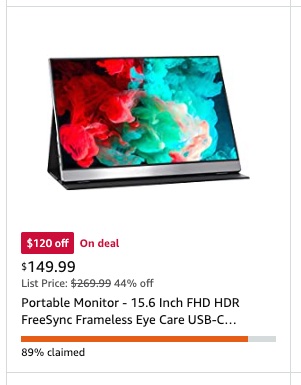Amazon offers several different types of deals and discounts.
Utilizing these deals and discounts can impact your click-through rate, conversion, and even the overall success of your product launch.
In this article, we will outline the types of deals and discounts Amazon makes available to sellers and how you can utilize them to help drive awareness and sales for your products.
Lighting Deals
-
Screenshot from Amazon, September 2022

-
 Screenshot from Amazon, September 2022
Screenshot from Amazon, September 2022
- Lighting Deals and 7-Day Deals show on the Today’s deal page. Lighting Deals also show the percentage of items claimed.
Lightning Deals are probably the most well-known deal on Amazon.
When you run a Lighting Deal, it runs for a specific time set, and you commit to a specific number of units.
These deals are highlighted on the Today’s Deals page with the Limited Time Deal badge and the discount percentage.
Outside of the Today’s Deals page, the badge and discount percentage also show in the search results.
 Screenshot from Amazon, September 2022
Screenshot from Amazon, September 2022
With Lightning Deals, you select a specific number of units to be included in the deal, and a countdown of the percentage of discounted units displays on the product detail page.
The actual product detail page shows a countdown of the total number of units still available as part of the deal in the area next to the product’s Buy Box.
Together, the badge, percentage off, and the claimed percentage can increase impulse purchases by increasing a sense of scarcity for this deal.
With Lightning Deals, one thing to remember is that you have little to no control over when your deal will run.
While you can select a deal window where you know your deal will run, you cannot select the exact date and time.
If you select a deal during an event like Prime Day, the deal will run only during the event, but you will not be able to select the day or time.
For non-events, there will typically be a list of weeks for you to choose from for a deal fee. For non-peak shopping days, this fee is usually $150. The fee for Prime Day, Black Friday, and Cyber Monday can be significantly more.
According to Amazon:
“A Lightning Deal is a time-bound, promotional offer where an item is featured for a limited number of hours, usually 4 to 12 hours (as determined by Amazon), on the Amazon Deals page.”
So your deal may run on a Tuesday from 9 a.m. to 9 p.m. PST, or your deal could run from 1 a.m. to 5 a.m. PST on a Sunday.
While, of course, the time the deal runs can impact the effectiveness of your lighting deal, the type of product you are offering can also significantly impact the number of customers interested in your deal.
In our experience, items a customer might have been looking for an excuse to buy do the best for Lighting deals.
Maybe they have been eyeing that Roomba, LEGO Set, or luxury home product, but have been watching for a discount that would justify splurging on the item.
These items do the best with Lightning deals. The short duration of these deals provides the scarcity needed to compel purchases.
Commodities and items like groceries tend to underperform in Lightning Deals compared to the results of the products that are more coveted, as mentioned above.
7-Day Deals
If you are looking for a little bit more control on when your promotion will be run, you might want to look at 7-Day Deals. As the name suggests, these deals run for a full seven days.
While you will not get the countdown on the number of units offered, your deal will be featured on the Today’s Deal Page and show the discounted amount in search.
7 Day deals do not require you to select a specific number of units to commit to. They also provide enough time to amplify your deal via social media and your email list if you desire. These deals have a fee that starts at $300.
We recommend that you test both Lighting Deals and 7-Day Deals to determine their effectiveness for your product mix.
Event Deals
Deadlines for event deals can vary by account. For deals like Black Friday, Cyber Monday, and Prime day, you need to check your Deals Dashboard in Seller Central. You will see that in the dashboard if you are eligible to submit a deal.
The deal fee for 7-Day Deals and Lighting Deals for events is more expensive than for non-event dates. That’s because Amazon anticipates significantly more potential traffic to your deal during these times.
Remember, even if you are too late to secure a deal for Black Friday, you can often still submit a deal for the period between Cyber Monday and Christmas, for instance – as well as run Prime Exclusive Discounts and Coupons.
Eligibility
Amazon outlines in detail what is required for a deal to be eligible for a 7-Day Deal or Lighting deal in its support documents.
To be eligible for deals, you must be a professional seller with an overall rating of at least 3.5-stars. Additionally, products must meet these criteria:
- Have a sales history in Amazon stores and at least a 3-star rating.
- Include as many variations as possible.
- Not be a restricted product or offensive, embarrassing or inappropriate product.
- Be Prime eligible in all regions.
- New condition.
- Be compliant with customer product review policies. To learn more, go to Customer product reviews policies.
- Compliant with pricing policies and have a valid reference price. For more information, go to Show a reference price on your products and Amazon Policy on Reference Prices.
- Compliant with deal frequency requirement. To learn more, go to Create a Deal.
Not every product is eligible to run deals. You cannot submit a deal if your product does not appear eligible in the Deals Dashboard in Seller Central.
It is also important to note that any coupons or discounts run simultaneously will be combined with your deal.
That means the coupon will still be available on top of the discounted price available through your 7-Day Deal or Lighting Deal.
For both deal types, Amazon will provide a minimum discount per unit that would need to be offered for the deal to be eligible.
Discounts
In addition to deals, Amazon also provides two different types of discounts you can run on your Amazon product detail pages.
These are Prime Exclusive Discounts and Coupons. Discounts don’t require the same lead time as deals and have less stringent eligibility and discount requirements.
Let’s go through the details for each type of discount.
Coupons
Coupons are great tools for increasing your conversion rate. These coupons show in search and on the product detail page.
Because these deals show in both ads and search, coupons can also increase your CTR for well-optimized products.
All products are eligible for coupons. With coupons, you are only charged $0.60 when a coupon is redeemed. You will not be charged if a customer clicks a coupon but does not check out.
You can also see how many people clipped your coupons versus redeeming them. This reporting is found in Seller Central under Advertising > Promotions.
Prime Exclusive Deals
Prime Exclusive Deals (PED) are only available to Prime members. If a customer is not a member of Amazon Prime, they will have the option to join Prime.
While there is no charge for these discounts, there are stricter requirements around what products are eligible for Prime Exclusive Deals compared to coupons at the time of this writing. Additionally, customers will not need to clip or redeem this offer; it is available automatically.
When first launched, Prime Exclusive Deals appeared with a badge and discounted amount – in both search results and the product detail page.
In the last week, Prime Exclusive Deals have only shown some products’ Prime Exclusive Deal information on the product detail page.
Amazon provides the requirements for Prime Exclusive Deals within the Prime Exclusive Deal workflow as follows:
- The item needs to be a nationally Prime shipping eligible product.
- The Prime Exclusive Discount must meet all regular eligibility criteria.
- The product must have at least a 3.5-star rating or no rating.
- The discount must be at least 20% off the non-Prime member’s non-promotional price.
- The discount must be at most 80% off the non-Prime member’s non-promotional price.
- The discount must be lower than the reference price (that is, List Price or Was Price). Learn more about Reference Prices and how to show a reference price to your products.
- The Prime Exclusive Discounted price must be lower than the lowest price for the ASIN in the past 30 days. The lowest price in the last 30 days is the lowest order price for the ASIN in that period, including all deal, promotional, and sale prices across all merchants.
- You must be a seller with at least 4 Seller Feedback Rating when the seller rating is available. Amazon looks at the last 365-day rating average if there are 10 or more ratings in that period. If there are less than 10 ratings in the last 365 days, Amazon considers the lifetime average rating.
*Note: A different set of criteria is posted in Seller Help documents; however, we find that the items within the workflow are the most accurate.
Testing Your Pricing With Deals
Prime Exclusive Deals and Coupons can be a great way to test a lower price for your items.
If you are concerned that your pricing might deter potential customers, we always recommend that you test a lower price with a discount before lowering your overall price.
Simply lowering the price on your product, instead of testing with a discount, can cause Buy Box suppression if you decide to return to the original higher price.
If Amazon sees your current price on Amazon is higher than the average over the last 30 days, Amazon will often suppress the Buy Box on your items.
A suppressed Buy Box can cause your conversions to decrease significantly.
When the Buy Box for your products is suppressed, customers must click about three extra times to make a purchase. Also, you will be unable to run any ads while your product’s Buy Box is suppressed.
Testing with deals instead of simply lowering your price allows you to have the data you need to make an informed decision about whether or not to lower your price. It also limits any potential long-term negative effects on your product’s listing.
When Not To Use Deals And Discounts On Amazon
Discounts and deals can help you rank your products and increase brand awareness. However, there are times when it could be better not to run deals on Amazon.
Low Inventory
When considering running a deal, you also want to consider your current stock level and lead times. One of the benefits of increasing your sell-through rate is that it will naturally improve your organic ranking.
However, if your deal causes you to sell out, you will lose any organic ranking gains from your deal.
When determining if you should run a deal, make sure that even if the deal goes well, you will still have enough units on hand to avoid any stockouts.
Low Profitability
While running deals can help with the successful launch or ranking campaign, it is important to look at overall profitability when considering deals.
A coupon might significantly impact profitability on items with a smaller average order value. This is especially true if you plan on running deals regularly.
Amazon now provides detailed SKU economics, including inbound shipping and your Sponsored Products costs. You can use this to help determine if your product has enough margin to sustain a profitable deal.
Audience Expectations
We have found that non-luxury consumables tend not to perform as well with deals and discounts because the discounts tend not to be large enough to motivate buyers.
Consider if your audience is looking for a deal or if they are coming to your product ready to purchase it regardless of any discounts.
At the end of each deal, review your overall sales and conversion rate to evaluate the impact of your deal or discount. Will Haire, Co-Founder of BellaVix, shared advice:
“During strategic holidays like T5 (BF-CM) or Prime Day, shoppers expect to find deals on Amazon when shopping. We always recommend accepting deals when they become available. You can always cancel them up until the moment they go live.
Coupons are a performance-based promotion, which means you are only charged after the shopper clips and purchases a product.
We recommend trying out the different types of deals, and we find that the Prime exclusive deals tend to be the most successful in terms of sales and worth the upfront investment.
When experimenting with price points, we will leverage deals or coupons to measure any change in sales velocity, indicating if we are priced too high in the market.”
Understanding the different types of deals and discounts available for your products on Amazon will help you maximize their effectiveness as you head into your busy season or launch new products.
More resources:
Featured Image: 1981 Rustic Studio kan/Shutterstock
window.addEventListener( ‘load’, function() {
setTimeout(function(){ striggerEvent( ‘load2’ ); }, 2000);
});
window.addEventListener( ‘load2’, function() {
if( sopp != ‘yes’ && addtl_consent != ‘1~’ && !ss_u ){
!function(f,b,e,v,n,t,s)
{if(f.fbq)return;n=f.fbq=function(){n.callMethod?
n.callMethod.apply(n,arguments):n.queue.push(arguments)};
if(!f._fbq)f._fbq=n;n.push=n;n.loaded=!0;n.version=’2.0′;
n.queue=[];t=b.createElement(e);t.async=!0;
t.src=v;s=b.getElementsByTagName(e)[0];
s.parentNode.insertBefore(t,s)}(window,document,’script’,
‘https://connect.facebook.net/en_US/fbevents.js’);
if( typeof sopp !== “undefined” && sopp === ‘yes’ ){
fbq(‘dataProcessingOptions’, [‘LDU’], 1, 1000);
}else{
fbq(‘dataProcessingOptions’, []);
}
fbq(‘init’, ‘1321385257908563’);
fbq(‘track’, ‘PageView’);
fbq(‘trackSingle’, ‘1321385257908563’, ‘ViewContent’, {
content_name: ‘running-amazon-deals-discounts’,
content_category: ‘ecommerce seo’
});
}
});


